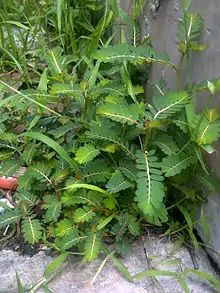Phyllanthus urinaria
Phyllanthus urinaria, commonly called chamber bitter,[1] gripeweed, shatterstone, stonebreaker or leafflower, is a herb species in the family Phyllanthaceae.
| Phyllanthus urinaria | |
|---|---|
 | |
| Scientific classification | |
| Kingdom: | Plantae |
| Clade: | Tracheophytes |
| Clade: | Angiosperms |
| Clade: | Eudicots |
| Clade: | Rosids |
| Order: | Malpighiales |
| Family: | Phyllanthaceae |
| Genus: | Phyllanthus |
| Species: | P. urinaria |
| Binomial name | |
| Phyllanthus urinaria | |
Plant description
The plant, reaching around 2 feet, has small alternate leaves resembling those of the genus Mimosa, disposed in two ranges. The leaves are large at the tip and smaller towards the petiole. The leaves are closed at night and are open in the day. Flowers are greenish white, minute and appear at axiles of the leaves, as well as the seed capsules. Numerous small green-red fruits, round and smooth, are found along the underside of the stems, which are erect and red.

This plant is considered a competitive weed in some regions, because of its great number of seeds, its high shade tolerance and its extensive root system.
Distribution
Although of Asian origin, the weed is widely found in all tropical regions of the world. In the United States, it is found in southern states such as Virginia,[2] Florida, Georgia, Alabama, South Carolina, New Mexico or Texas. It is a warm-season, annual, broadleaf weed that emerges from warm soils beginning in early summer. It reproduces by seeds, which are found in the green, warty-like fruit attached to the underside of the branch
Germination
The plant is a summer annual and germinates from early summer to early fall, requiring warm soil and light.[3]
References
- "Phyllanthus urinaria". Natural Resources Conservation Service PLANTS Database. USDA. Retrieved 30 September 2015.
- "Digital Atlas of the Virginia Flora | Phyllanthus urinaria L. ssp. urinaria". vaplantatlas.org. Retrieved 2018-09-26.
- Wehtje, Glenn R.; Gilliam, Charles H.; Reeder, Jesse A. (1992). "Germination and Growth of Leafflower (Phyllanthus urinaria) as Affected by Cultural Conditions and Herbicides". Weed Technology. 6 (1): 139–143. doi:10.1017/S0890037X00034448. ISSN 0890-037X.